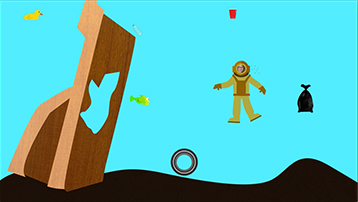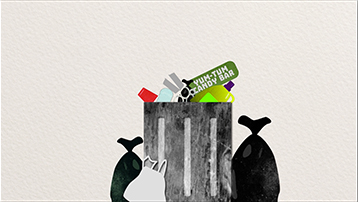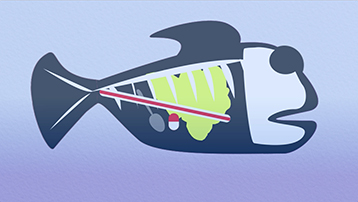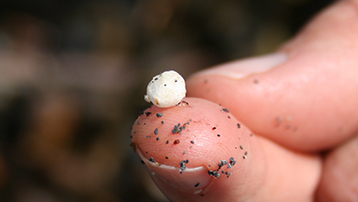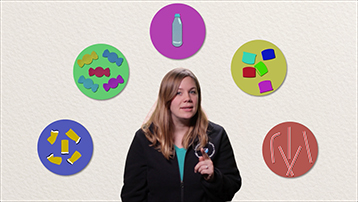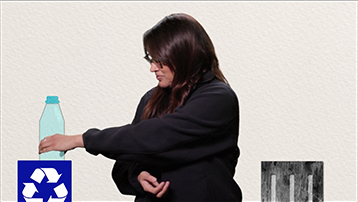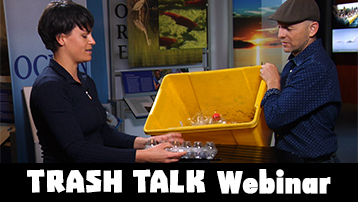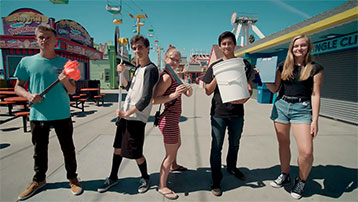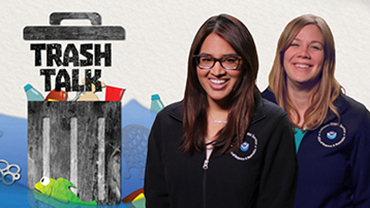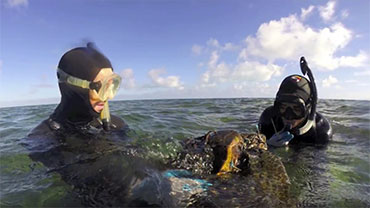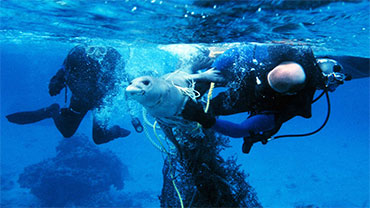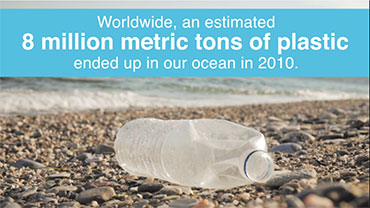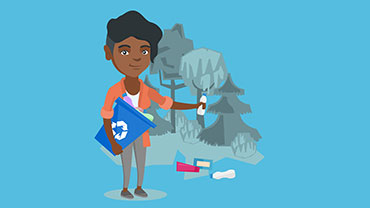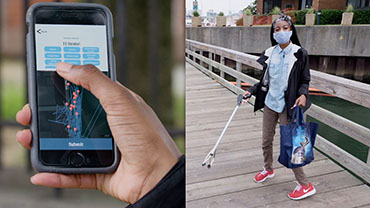Transcript
NARRATOR:
Ocean Today is premiering this 15-minute TRASH TALK special feature for World Ocean Day. It is specially designed to be part of your World Ocean Day festivities and beyond. In addition to the video, we have a pre-recorded 10-minute webinar for educators that provides fun activities that you can organize after the film! A perfect event for museums, zoos, aquariums, learning centers and schools.
On the right, under 'Related Videos', you will find each of the chapters contained in this special feature. Each stands on its own, so we have created a separate page that can be referenced.
NARRATOR:
We love the ocean. And you love something, you want to protect it.
Unfortunately, the ocean is being filled with trash. And people all over the world who care about the health of the ocean are doing something about it. They're talking trash and taking action.
You probably already recycle, and that's a great start. So now, let's talk about how you can prevent some of the surprising and sneaky ways that trash flows into our rivers and the ocean.
Come learn about marine debris and be part of the action.
There's a problem with trash in the ocean all over the world. People are generating more trash than ever, and sometimes that trash travels from cities to streams, rivers, bays, and then into the ocean, where it sometimes causes harm to coastal communities and wildlife.
This issue also costs communities money when people avoid beaches and bays because of all the trash.
Don't you think it's time all have an honest trash talk? We love the ocean, like you do, and we want to take care of it.
So the burning question I'm sure you're all asking is, what is marine debris?
Have you ever been to the beach and noticed litter, like plastic bottles or foam take-out containers on the sand? Or maybe you've been to a river or bay where there's a car tire or bags stuck in the mud on the shore? Or a bunch of deflated balloons that say Happy Birthday floating in the water? All of that junk in the water, or on the shoreline, is considered marine debris. It's anything solid and man-made in the ocean or Great Lakes that is not supposed to be there. And anything people use every day can become marine debris if they don't dispose of it properly. And I mean anything!
The most common items we find when we do shoreline cleanups are plastics. But we also find rubber, cloth, glass, metal, and paper litter. Sometimes, the debris is so tiny, like a plastic microbead from your face wash, that you can barely see it in the water.
Marine debris is more than just trash in the ocean. Sometimes fishers lose their gear, like fishing traps, nets, or fishing line, and it continues to drift through the water, catching animals for a long time. We call that derelict fishing gear, and it's marine debris. Have you ever seen an old boat left behind on a shoreline? Abandoned and derelict vessels are also marine debris.
So let's review. Anything we use every day can become marine debris if we don't dispose of it properly or if it goes into the water by accident. Marine debris can be very small, or can be very big, and anything in between. But most importantly, marine debris is one of the biggest pollution problems facing the world's oceans and waterways today.
Almost 4 in 10 Americans live in cities directly on the shoreline. So there's a lot of trash generated from cities by the sea and the millions of people who visit our beaches. What might amaze you is all the other places trash can come from, and how far it can travel.
Marine debris comes from many different sources and enters the ocean in many ways.
Intentional littering and dumping are a big cause of marine debris. Sometimes the trash goes directly into the ocean, like when beachgoers don't pick up after themselves. Or sometimes, marine debris is indirectly generated in a city hundreds of miles from the ocean. When someone litters on the street or parking lot, rainwater can move the trash into storm drains that empty into streams, rivers, and other bodies of water. Or, the wind can blow it there. Those rivers and streams can eventually carry the trash to the ocean.
Improper or careless waste disposal is another big cause. Have you ever seen an overflowing trash can, but for some reason, people keep putting trash there? Hello, marine debris! Or someone throws a piece of plastic in the trash, when it should have been recycled? Around the world, many people don't have access to proper waste disposal or recycling – but the trash keeps piling up, and it has to go somewhere.
It's not just here on land – marine debris comes from activities out on the water, too. People on boats sometimes throw their trash overboard, and that's against the law. Or, trash can accidentally fall, blow, or wash off vessels into the water. Sometimes fishers lose their fishing gear thanks to storms or passing vessels. Once the debris gets to the ocean, it is very difficult to trace the exact source.
The bottom line is, marine debris comes from us. Humans are the source, and every single person has the power – and the responsibility – to prevent it.
So yes, trash comes from cities, like right here in Washington, D.C., the nation's capital. The Potomac River flows all the way into the Atlantic Ocean, and all kinds of stuff can end up in the water if people aren't careful. The cherry blossoms are in bloom, and it's beautiful. But look at how much trash people are creating. Bags and bottles can end up in the river, blown by the wind or washed down by the rain. We're going to talk about solutions a little later on, but first, let's have some trash talk about why we should care.
How does marine debris impact the ocean, animals, and me?
Would you want to swim at a beach littered with trash? Of course not. And the animals who live in the ocean don't either - the difference is they don't have a choice.
Marine species often get tangled in debris, from fishing nets to six-pack rings. If they get caught, they could get injured or even die. Even if they don't get entangled, many animals mistake plastic debris for food, and eat it. This fills their stomachs with junk they can't digest.
Debris can also damage important habitats, like coral reefs, by breaking or smothering them. Corals serve as the base of the marine ecosystem, and impacts here can be felt all the way to you and me. Plus, plastics have harmful chemicals in them. Fish eat plastic. We eat fish. The question is, can those chemicals harm us? Marine debris also hurts the economy. It costs a lot of money to clean up, and people don't want to go to dirty beaches. Boats and ships could run into large pieces of debris, too, or get their propellers tangled.
We need the ocean - and everything in it. And the ocean needs us to keep it free of debris.
So now you've heard about all the different kinds of marine debris and their impacts on the ocean. That may seem far away from you, but really, the problem may start in your front yard. When we take out trash and recycling, we need to do a good job of keeping it contained, like we have here. But you can't control it all. So when you pick up your trash and recycling cans, be sure to pitch in and pick up anything that may have fallen out. And they did a really good job.
There's a lot of waste that does end up as marine debris. But by far, the most significant material that ends up in the ocean is plastic.
Why is plastic marine debris so common?
We know there's a lot of trash in the ocean. Unfortunately, a lot of it is plastic. We find plastic everywhere from the ocean's floor to surface. The plastics are all shapes and sizes and all different types. We find it on beaches and inside animals' stomachs or wrapped around their bodies. That's bad news for our ocean and the animals that live in it or near it. It's also bad news for us.
A recent study from the University of Georgia estimated that 8 million metric tons of plastic trash enters the ocean every year. That's like putting five bags filled with plastic on every foot of coastline in the world. That's a LOT of plastic in the ocean, and it's there because... well, we put it there!
The 5 most common items found during the International Coastal Cleanup are plastic cigarette butts, food wrappers, plastic beverage bottles, plastic bottle caps, and plastic straws & drink stirrers. Notice anything in common with those things? It's a lot of single-use, disposable plastic.
It goes without saying – we produce too much waste. That waste ends up in the ocean when we litter or don't recycle. Plastic is an important part of our modern lives - we use it for a lot of good things! But we need to take responsibility for how much we use every day and where it goes when we're done with it.
The three R's can help – and it's up to every single one of us to practice them. Reduce the amount of disposable plastic you use. That's anything you use once and throw away. Just use less. Reuse disposable plastics when possible. A plastic bottle makes a great coin piggy bank or watering can. The possibilities are endless. Recycle anything that can be recycled, so it stays out of landfills, where trash can blow away.
Ocean plastic is a huge problem that's only going to get worse if we don't change our ways. We can do better – for the ocean, and for us.
As you can see, trash can flow from your neighborhood into a drainpipe, then down into a stream like the one behind me, and believe it or not, it can make it all the way to the middle of the ocean.
What is the Great Pacific Garbage Patch?
Well first, let's talk about what it's not. It's not a floating island of trash, like a garbage dump or a landfill. It's also not the only patch. They exist all throughout the ocean, and the Pacific Garbage Patch just happens to be the most famous.
Garbage patches are large areas of marine debris concentration that are formed by rotating ocean currents called gyres - kind of like big whirlpools that suck things in. A garbage patch is made up of tiny plastic pieces called “microplastics” that are less than 5 millimeters long. It's more like pepper flakes swirling in a soup than something you can skim off the surface. You might come across some larger items, like plastic bottles, but it's possible to sail through a garbage patch and not see anything. And they're a big problem, for the ocean - and us.
People often ask why we can't just scoop up all the marine debris in the ocean, and the answer is: unfortunately, it's just not that simple.
The first challenge is the sheer size of these garbage patches. They're huuuuuge! They're constantly moving with ocean currents. And there's debris from the ocean's surface all the way down to the sea floor. Not to mention all the marine life we would disrupt if we tried to just scoop up debris.
So what can we do? Well, the ultimate solution is prevention and we need to keep that as our highest priority. We can reduce, reuse, and recycle to keep trash out of the ocean in the first place. And we can participate in things like shoreline cleanups. It's a lot easier to deal with debris before we get to the ocean.
Because until we stop marine debris at the source, we'll just be cleaning it up forever.
Communities across the country are coming up with innovative ways to prevent debris from leaving the watershed, like this water wheel here in Baltimore. And also in D.C., Missouri, San Francisco, Los Angeles, and Honolulu. Innovative solutions are popping up everywhere.
Look at all this trash. As you can see, we really need to work on stopping debris at the source. This is one way cities are working on it, but what can you do?
Let's dive into how we can prevent trash from entering the water in the first place.
What can we do about marine debris?
A lot of the trash that's in our ocean is plastic, and that marine debris is hurting our environment, economy, and health. The problem will only get worse unless we change the way we consume and dispose of products.
Some people may say, well, I'm just one person, so I can't make a difference. But that's just not true! If each person who creates trash (and that's just about everyone) took action, it would add up to a lot of change.
There are solutions, and together, we can prevent litter from ending up in the ocean. So what can we do? Well, the ultimate solution is prevention, and we need to keep that as our highest priority. We can reduce, reuse, and recycle to keep debris out of the ocean in the first place. You can bring your own shopping bag, drink out of a reusable bottle, and participate in things like a shoreline cleanup. Join a group cleaning the beach, or grab some friends and clean up your street! It's easy. Be more conscious of how many disposable plastic items you're using, and if you do - where are you putting it...in the recycling bin or the trash can?
So here's a challenge: the next time you finish using a throw-away item: a bag, bottle, or utensil, answer the question, “Where is this going?” Because ultimately when you throw stuff away, there really is no away...it has to go somewhere.
So keep asking yourself this important question...How will you keep your trash from becoming marine debris?
Human beings are creating this problem, and it's unhealthy for us, the Earth, and all the creatures depending on it.
But we can come together and build a movement and change our relationship with trash. Which is why we're encouraging everyone to have a trash talk with your friends, neighbors, family, and even city officials.
So we're all in this together. And if we focus on solutions and prevention, we can make the ocean and the Earth a healthy home for everyone.
 An official website of the United States government.
Here's how you know we're official.
An official website of the United States government.
Here's how you know we're official.


